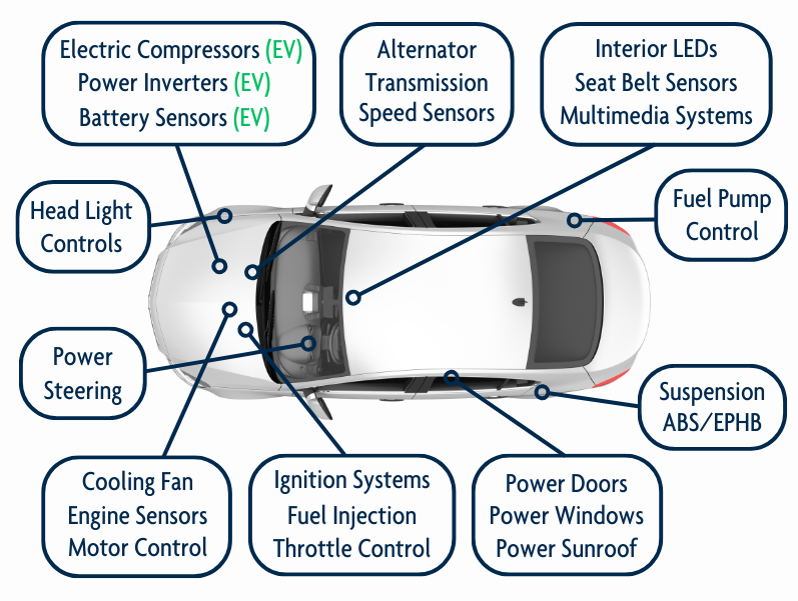5 Innovations and Trends in Power Semiconductors for Electric Cars
The dawn of the electric vehicle (EV) era has ushered in an exciting period of transformation in the automotive industry. As electric cars continue to gain traction, their underlying technology has become a focal point of innovation. At the heart of this transformation lies power semiconductor technology, a critical component that determines the efficiency, performance, and sustainability of EVs.
In this exploration of innovations and trends in power semiconductor technology for electric vehicles, we’ll dive into the key developments shaping the future of the EV market.
HOW ARE SEMICONDUCTORS USED IN ELECTRIC CARS?
Semiconductors, the unsung heroes of modern electronics, are indispensable for electric vehicles. These tiny but mighty components facilitate the conversion of electrical energy from the battery into power that drives the vehicle’s motor. They also play a crucial role in managing energy efficiency, motor control, and the overall performance of electric cars.
In [our last post], we learned that newer EVs can contain upwards of 3,000 semiconductors! There’s also an infographic that shows all the systems and applications they’re involved in throughout a modern vehicle, so be sure to check that out as well. Now, let’s delve into the most innovative trends that are propelling the power semiconductor technology landscape for electric vehicles.

5 TRENDS IN POWER SEMICONDUCTORS FOR ELECTRIC CARS
1. Wider Usage of Wide-Bandgap (WBG) Devices
Wide-bandgap semiconductor materials, such as silicon carbide (SiC) and gallium nitride (GaN), have emerged as game-changers in the world of power electronics. These materials possess superior electrical properties, including higher breakdown voltage and faster switching capabilities. This means they can handle higher power levels while maintaining efficiency, making them ideal for EVs.
Wide-bandgap devices have started to replace traditional silicon-based semiconductors in EV power conversion systems. SiC and GaN offer lower switching losses and reduced heat generation, leading to increased efficiency and longer driving ranges. As a result, electric vehicles equipped with WBG devices experience less energy wastage and can travel farther on a single charge.
2. Increased Switching Frequencies
The electrification of vehicles has led to a shift towards higher switching frequencies in power semiconductor devices. This trend is particularly prominent in motor drive inverters, which are essential for controlling the speed and direction of the electric motor.
Higher switching frequencies allow for finer control over the motor, resulting in smoother and more precise acceleration and deceleration. This not only enhances driving comfort but also contributes to energy efficiency. The rapid switching of semiconductors reduces power losses, making electric vehicles more energy-efficient and extending their battery life.
3. The Introduction of New Alternative Semiconductor Materials
In the quest for further innovation, researchers and manufacturers are exploring alternative semiconductor materials beyond the conventional choices of silicon, SiC, and GaN. One such material gaining attention is synthetically produced diamond.
Diamond semiconductors offer remarkable thermal conductivity and electrical properties, making them ideal for high-power applications in electric vehicles. With the ability to dissipate heat efficiently, diamond semiconductors can withstand higher operating temperatures. This translates to improved power density and longer lifespans for EV components.
While diamond semiconductors are still in the research and development phase, their potential to revolutionize power electronics for electric vehicles is undeniable. They could pave the way for even more compact and energy-efficient systems in the near future.
4. Enhanced Packaging Technologies
Innovations in power semiconductor packaging technologies are another crucial trend in the EV industry. As power electronics become more integrated and compact, the need for efficient cooling and heat management is paramount.
Advanced packaging solutions, such as silicon interposers and direct liquid cooling, are being adopted to address the challenges of thermal management. These technologies ensure that power semiconductor devices can operate at optimal efficiency even under high-load conditions.
Moreover, enhanced packaging techniques contribute to the miniaturization of power electronics, freeing up space within the vehicle for other components or improving aerodynamics. This trend aligns with the automotive industry’s ongoing pursuit of lighter, more efficient, and longer-range electric vehicles.
5. Development of Intelligent and Adaptive Semiconductors
Electric vehicles are not just about driving from point A to point B—they are evolving into intelligent mobility platforms. To help support the development of autonomous and connected vehicles, semiconductors are becoming more intelligent and adaptive.
Semiconductor manufacturers are incorporating advanced sensors and control algorithms directly into their power semiconductor devices. This enables real-time monitoring of the vehicle’s performance and environmental conditions. As a result, semiconductors can adjust their operating parameters to maximize efficiency and safety.
For example, semiconductors can adapt to various driving conditions, optimizing power delivery for increased range in adverse weather or terrain. They can also contribute to predictive maintenance, identifying potential issues before they become critical.

POWER SEMICONDUCTORS ARE SHAPING THE FUTURE OF TRANSPORTATION
The innovations and trends in power semiconductor technology for electric vehicles are steering the automotive industry toward a cleaner, more efficient, and more intelligent future. With the adoption of these power semiconductor trends, EVs are set to become the standard for sustainable and high-performance transportation.
As the electric vehicle landscape continues to evolve, the power semiconductor industry will remain at the forefront of innovation. The question is no longer, Do electric cars use semiconductors? It’s how these semiconductors are propelling us into a new era of mobility.
If you’re interested in delving further into the world of power semiconductors and their applications in the EV industry, we encourage you to explore our Automotive Semiconductors page. And if you’re an automotive manufacturer looking to improve your vehicles’ safety, range, and driving experience, Polar is the semiconductor company you can trust to power your next-gen systems. Let’s work together!
